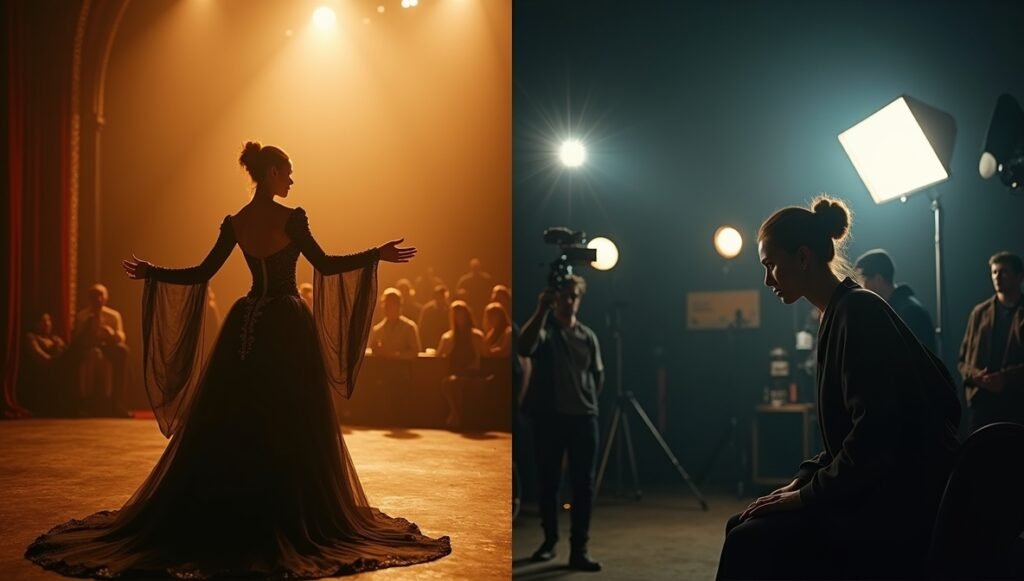Have you ever wondered why some actors shine on stage but look weird on camera? Or why that amazing movie star seems lost when they try theater? It’s not that they’re bad actors. They just haven’t learned the different skills each medium needs.
Acting is storytelling, no matter where you do it. But the way you tell that story changes big time between stage and screen. Think about it like this: telling a joke to your friend sitting next to you is different from telling it to a huge crowd. Same joke, different delivery.
I’ve seen many actors struggle when they switch between these worlds. Stage actors often look too big on camera. Screen actors sometimes can’t reach the back row of a theater. But here’s the good news: once you understand what each medium wants, you can master both.
This guide will show you exactly what makes stage and screen acting different. You’ll learn the specific skills for each one. Plus, I’ll give you practical tips you can use right away. Whether you’re just starting out or want to expand your range, this will help you succeed in both worlds.
Physical Performance and Movement
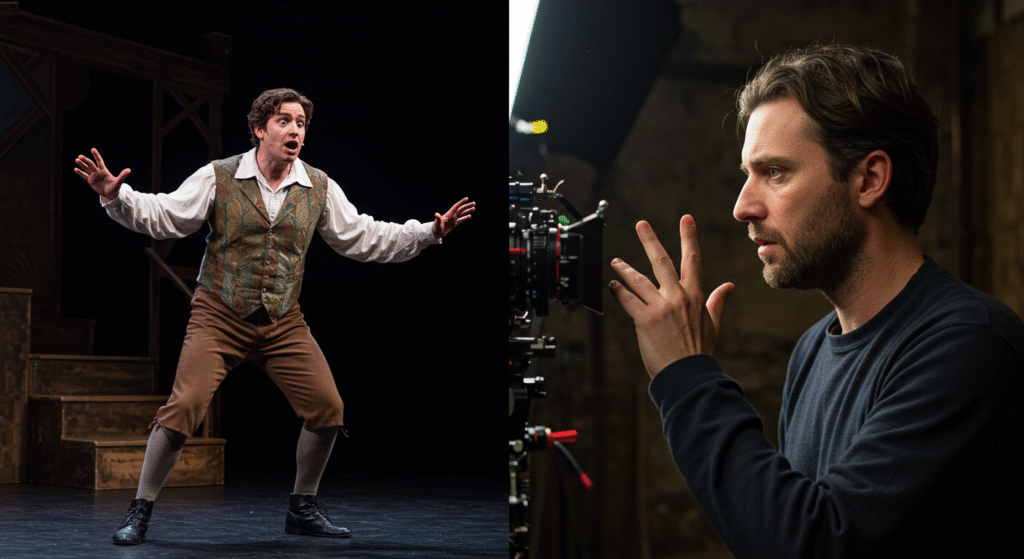
Stage acting needs big movements. Really big. You have to reach people sitting way in the back. Your gestures need to be clear from 200 feet away. That little hand wave you use in normal conversation? It disappears on stage. You need to think bigger.
Stage actors learn to use their whole body. Every movement has purpose. You can’t just scratch your nose without thinking about it. The audience needs to see what you’re doing and why. It’s like painting with broad brushstrokes instead of tiny details.
But cameras are totally different. They catch everything. That tiny eyebrow raise? The camera sees it. That slight hand tremor when you’re nervous? It shows up crystal clear. What feels normal in real life works great on camera. What works on stage looks crazy on screen.
Screen actors learn to trust small movements. A glance can say more than a big gesture. Sometimes doing less gives you more power. The camera loves honesty and hates fake movements.
Stage Acting Movement Tips: • Make your gestures 30% bigger than normal • Use your whole body to show emotions • Think about people in the cheap seats • Every movement should have a reason • Stand tall and take up space
On-Camera Movement Tips: • Keep movements natural and small • Let your face do the heavy lifting • Don’t fidget or make random gestures • Stay aware of the camera frame • Trust that tiny changes show up big
Voice and Vocal Projection

Your voice on stage has to fill the whole theater. No microphones to help you out. You need to reach the person in the last row without shouting. This takes serious training. You learn to breathe from your belly and support your voice with your whole body.
Stage actors develop vocal stamina. You might have to project for three hours straight. Your voice becomes like an athlete’s muscles. You train it, strengthen it, and learn to pace yourself. The challenge is staying clear and expressive while being loud enough.
Screen work is the opposite. Microphones pick up whispers. Sometimes you talk so quietly it feels weird. The challenge isn’t being loud enough. It’s being real enough. Cameras catch fake voices instantly. You need to sound like you’re having a normal conversation.
Many screen actors actually speak softer than in real life. The microphone is right there. It hears everything. You can use pauses and quiet moments. These would be lost on stage but they’re powerful on camera.
Stage Vocal Techniques: • Learn to breathe from your diaphragm • Practice speaking clearly and loudly • Build up your vocal stamina • Work on projecting without shouting • Keep your voice flexible and expressive
On-Camera Vocal Approaches: • Use your normal speaking voice • Practice talking softly but with energy • Learn to use pauses effectively • Work on natural speech patterns • Don’t worry about reaching the back row
Emotional Expression and Intensity
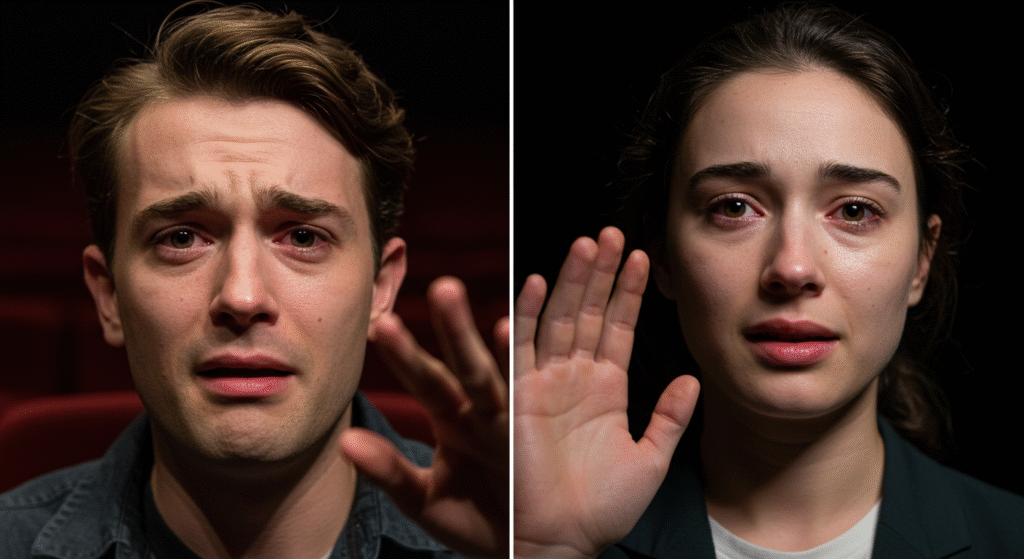
Stage emotions need to be bigger than life. Not fake bigger, but clear bigger. The person in row Z needs to see that you’re sad or angry. You learn to amplify real feelings. It’s like turning up the volume on your emotions while keeping them honest.
This doesn’t mean overacting. Good stage actors make big emotions feel real. They find the truth in heightened moments. You might hold a feeling longer than in real life. You might express it more clearly. But it still has to come from a real place.
Cameras love small emotions. They catch the tiny moment when doubt crosses your face. That split second of joy in your eyes. The way your shoulders drop when you’re defeated. All these tiny things become huge on screen.
Screen actors learn to think on camera. Sometimes just thinking an emotion is enough. The camera reads your thoughts through micro-expressions. Less really is more when every small change gets magnified.
Stage Emotional Techniques: • Practice making internal feelings visible • Learn to sustain emotions longer • Work on quick emotional changes • Use your whole body to show feelings • Build emotional stamina for long shows
On-Camera Emotional Skills: • Master the art of thinking feelings • Practice subtle emotional shifts • Trust that small changes show up big • Work on being vulnerable and honest • Learn that doing less can say more
Audience Relationship and Energy
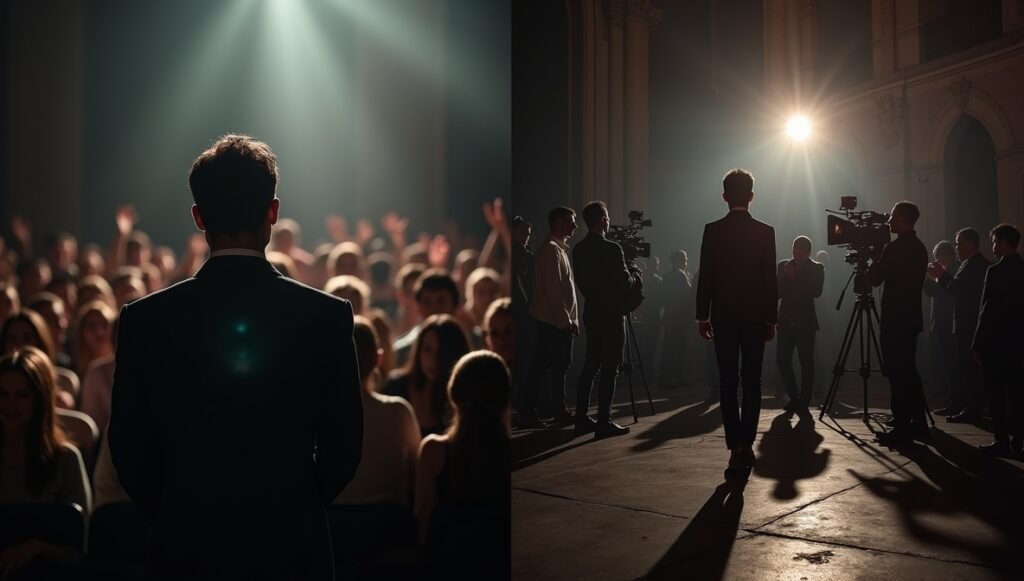
Stage acting is live. The audience is right there. They laugh, gasp, or sit in dead silence. You feel their energy and it changes your performance. Some nights the audience is hot and everything lands. Other nights they’re cold and you have to work harder.
This live connection is magical but tricky. You have to stay in character while reading the room. If they laugh at the wrong time, you wait. If they don’t laugh when they should, you don’t panic. The audience becomes part of the show.
On camera, there’s no audience. Just crew members, cameras, and lights. No one laughs at your jokes. No one gasps at plot twists. You have to create all that energy yourself. It can feel lonely at first.
Screen actors learn to be their own audience. You have to believe in your performance without outside validation. The real audience watches later, maybe months later. You’re performing for people you’ll never meet.
Building Stage Audience Connection: • Learn to read audience energy • Stay focused when they react unexpectedly • Practice projecting warmth to the whole room • Don’t let silence throw you off • Build confidence performing live
Mastering On-Camera Presence: • Create energy without audience feedback • Stay consistent across multiple takes • Ignore crew and equipment around you • Connect with imaginary scene partners • Trust your performance without validation
Memorization and Script Work
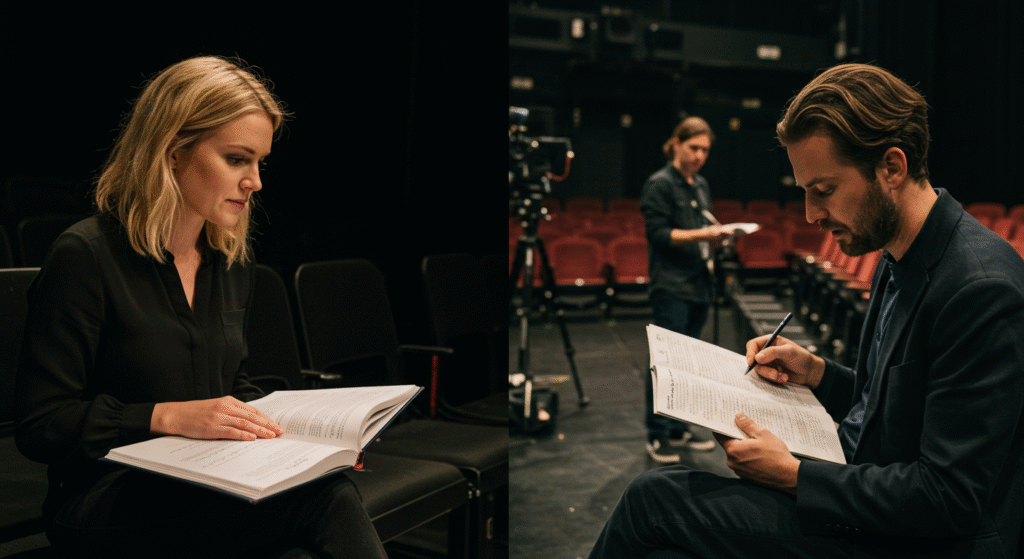
Stage actors memorize entire plays. Every word, every pause, every entrance. You can’t call “cut” and try again. The text has to be bulletproof in your brain. You practice until the words become automatic.
This goes beyond just knowing your lines. You need to know everyone else’s lines too. You need to know what happens before and after your scenes. The whole play lives in your head. Some actors even memorize the stage directions.
Screen work is different. Scripts change constantly. You get new pages the morning of shooting. Scenes get shot out of order. You might film the ending before the beginning. You need to be flexible and quick to learn new material.
Screen actors focus more on understanding their character than perfect memorization. You need to know where your character is emotionally in each scene. When scripts change, you adapt. When directors give new direction, you adjust.
Stage Memorization Strategies: • Start memorizing early in rehearsals • Learn lines along with blocking and movement • Know other people’s cue lines • Practice the whole show from start to finish • Have backup plans for memory blanks
On-Camera Script Preparation: • Be ready for last-minute script changes • Focus on character motivation over perfect lines • Learn to memorize quickly and efficiently • Stay flexible with dialogue changes • Understand your character’s journey
Timing and Pacing

Stage shows happen in real time. You control the rhythm. When the audience laughs, you wait. When they’re silent, you might slow down for drama. The pacing builds over two or three hours. You’re like a conductor leading an orchestra.
Comic timing is huge on stage. You learn to feel when a laugh is coming. You pause at just the right moment. You wait for the laugh to die down before your next line. It’s like a dance between you and the audience.
Screen pacing is totally different. Editors control the final rhythm. They might cut out your pauses. They might speed up slow moments. You give them options by trying scenes at different speeds. What feels right to you might not work in the final cut.
Camera work happens in short bursts. You might do a three-minute scene twenty times. Each take might have different pacing. Directors often ask for one version fast, one slow, one in between. You learn to be flexible with timing.
Stage Timing Techniques: • Learn to work with audience laughter • Practice building energy over long scenes • Match your timing with scene partners • Use pauses for dramatic effect • Keep energy up during quiet moments
On-Camera Pacing Skills: • Practice scenes at different speeds • Make quick transitions between emotions • Work on fast-paced dialogue delivery • Use meaningful looks and reactions • Keep energy up in short scene segments
Rehearsal Processes and Preparation
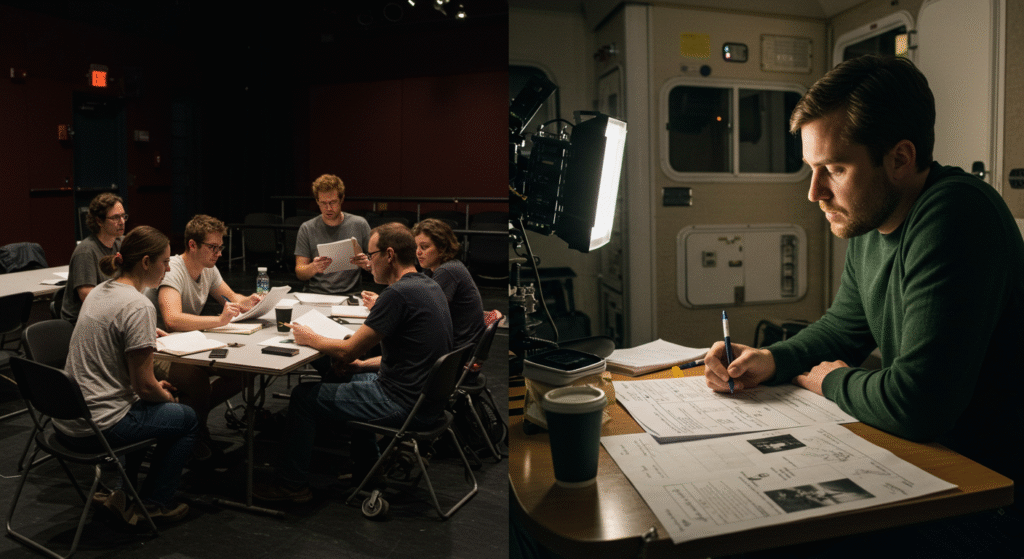
Theater rehearsals last for weeks or months. You explore your character slowly. You try different approaches. You build relationships with other actors. There’s time to experiment and make mistakes. The collaborative process creates the final show.
You start with table reads where everyone sits and reads through the script. Then you block scenes, figuring out where everyone moves. Finally, you run the whole show over and over. By opening night, everyone knows exactly what to expect.
Film and TV move much faster. You might meet your scene partner on the day you shoot together. There’s little time for exploration once cameras roll. You do most of your character work alone, before you arrive on set.
This means screen actors need to be super prepared. You can’t figure out your character during filming. You need to know who they are, what they want, and how they’d react in any situation. Preparation happens in your own time.
Stage Rehearsal Approaches: • Embrace the slow exploration process • Try different approaches in rehearsal • Build relationships with your cast • Use rehearsal time to experiment • Be open to director feedback
On-Camera Preparation Methods: • Do deep character work before filming • Practice scenes alone when possible • Research your character thoroughly • Prepare multiple ways to play each scene • Be ready to adjust quickly on set
Technical Considerations and Environment
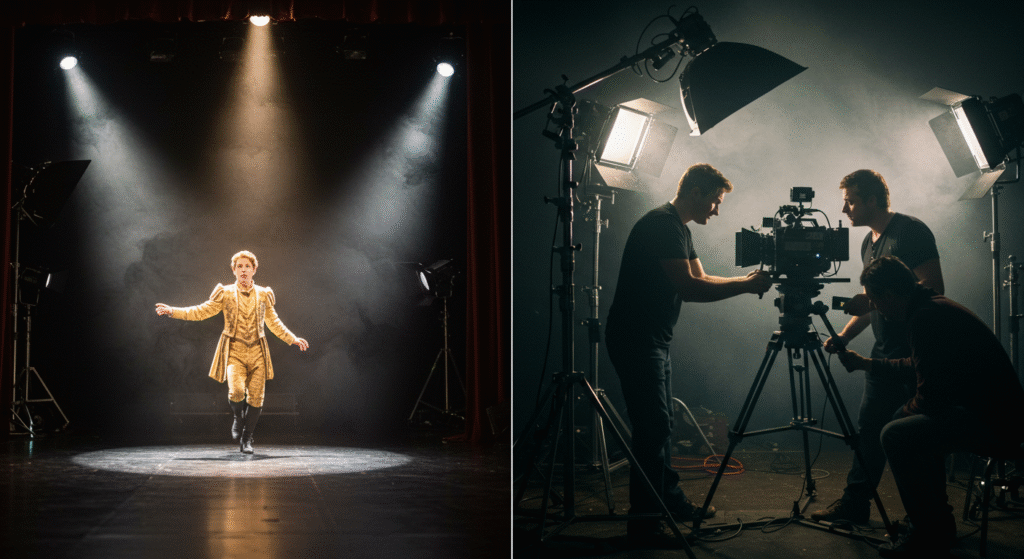
Stage technical elements stay mostly the same each night. The lights, sound, and set don’t change much once the show opens. You learn where everything is and how it works. After a few performances, you know exactly where that spotlight hits and how loud you need to be.
The consistency helps you get comfortable. You develop muscle memory for entrances and exits. You know which floorboard creaks and which door sticks. The technical elements become part of your performance.
Camera work changes constantly. Different shots need different lighting. Cameras move around. One minute you’re in a close-up, the next it’s a wide shot. You need to adjust your performance for each setup. What works in a close-up might not work in a wide shot.
Screen actors learn basic camera terms. When the director says “close-up,” you know to keep your movements small. When they say “wide shot,” you know you can use more space. Understanding the technical side helps you work better with the crew.
Stage Technical Awareness: • Learn how stage lights affect your visibility • Understand how your voice carries in the space • Know your blocking and sight lines • Get comfortable with costumes and props • Work with live sound and music cues
On-Camera Technical Skills: • Learn basic camera shots and angles • Understand how lighting affects your look • Practice hitting your marks naturally • Be aware of microphones and sound equipment • Stay consistent between different camera angles
Character Development Approaches

Stage characters develop over long rehearsal periods. You have time to build detailed backstories. You explore different sides of your character. The character grows and changes during the performance. There’s room for bigger personality traits.
Stage characters can be more theatrical while still feeling real. The heightened world of theater allows for broader choices. You might play someone more eccentric or extreme than you’d find in real life. The key is making them believable within the world of the play.
Screen characters need to feel like real people immediately. Viewers need to connect with them right away. There’s no time for slow character reveals. You have to show who they are quickly and clearly.
Camera characters are often more subtle and naturalistic. They need to feel like someone you might actually meet. The intimacy of close-ups means every choice gets scrutinized. Fake character traits stick out like sore thumbs.
Stage Character Development: • Build detailed character histories • Explore extreme personality traits • Create characters that evolve during the show • Develop physical and vocal characteristics • Make choices that read from far away
On-Camera Character Creation: • Focus on realistic human behavior • Develop subtle character quirks • Make characters immediately relatable • Show character through small actions • Create layered personalities that feel authentic
Industry Expectations and Professional Skills
Theater has its own business culture. You audition with prepared monologues. You might sing or dance. Callbacks involve reading scenes with other actors. The community is smaller and more relationship-based. Regional theaters, touring companies, and local productions each have different expectations.
Theater networking happens through schools, showcases, and working with other actors. Relationships matter more than in film. Directors remember actors they liked working with. Word of mouth is powerful in the theater world.
Film and TV move faster and reach more people. You need professional headshots and demo reels. Auditions happen on camera. Agents and managers help you get seen. The hierarchy is more complex, with more people involved in hiring decisions.
Screen industry networking is broader but sometimes less personal. Social media presence matters. You need to understand the business side: who does what, how projects get financed, and how to get your work seen by the right people.
Stage Industry Skills: • Prepare strong audition monologues • Learn to cold read scripts well • Build local theater relationships • Understand different types of productions • Develop self-marketing skills for smaller markets
On-Camera Industry Preparation: • Invest in quality headshots and reels • Master on-camera audition techniques • Learn industry hierarchy and roles • Build relationships with reps and casting directors • Develop social media and marketing presence
Cross-Training Benefits and Challenges

Many actors work in both worlds and find they help each other. Stage training builds strong foundations: voice work, physical presence, and emotional depth. Theater actors often bring more commitment and preparation to screen work. The discipline required for live performance creates good work habits.
The collaboration skills from theater serve screen actors well. You learn to work with directors and other actors. You develop confidence and presence that shows up on camera. The character work from theater creates more interesting screen performances.
Screen skills also help stage actors. The truthfulness required for camera work makes stage performances more believable. Learning to work with smaller expressions can add nuance to stage work. The adaptability needed for film helps with the unexpected moments in live theater.
The technical awareness from screen work helps stage actors too. Understanding how audiences see you differently from various distances and angles makes you a smarter stage performer. Quick preparation skills from film work help when you have to learn new material fast.
Benefits of Stage Training for Screen Actors: • Builds strong voice and physical skills • Develops confidence and stage presence • Creates thorough character development habits • Builds professional discipline and work ethic • Teaches collaboration and ensemble work
Benefits of Screen Training for Stage Actors: • Encourages authentic, truthful performance • Develops quick adaptation and flexibility • Builds comfort with technical elements • Provides experience with realistic character types • Creates efficiency in preparation and performance
Conclusion
Stage and screen acting are like two different languages that share the same alphabet. Both use storytelling, character work, and emotional truth. But the way you express these elements changes completely between the two mediums.
The best actors understand what each medium needs and adjust accordingly. They don’t fight against the requirements. They embrace them. Stage actors who try to act small on stage fail. Screen actors who try to act big on camera look ridiculous.
Learning both forms makes you a more complete actor. Stage work builds your foundation and gives you strength. Screen work teaches you subtlety and authenticity. Together, they create performers who can handle anything.
The entertainment industry needs actors who can move between stage and screen. Streaming services are creating more content than ever. Theater is finding new audiences through digital platforms. Versatile actors have more opportunities than specialists.
Start where your passion leads you, but don’t stop there. If you love theater, try some on-camera classes. If you’re drawn to film, take a stage acting workshop. Each form will teach you something new about the other. The skills you learn in one world will make you better in both.

